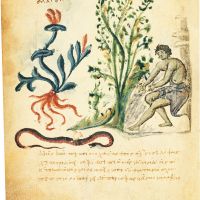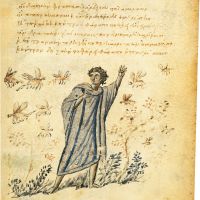Theriaka and Alexipharmaka by Nicander
Bibliothèque nationale de France, Paris
Shel-mark: Supplément grec 247.
Date: 10th C.
Size: 125 x 160 mm.
96 pages, 41 miniatures.
Bound in marble design, brown leather with red spine.
Leather case.
Commentary volume (372 p.) by Jean Pierre Angremy (Académie Française, Chairman of the Bibliothèque nationale de France), Alain Touwaide (Institute for the Preservation of Medical Traditions and Smithsonian Institution), Christian Förstel (Bibliothèque nationale de France) and Grégoire Aslanoff (Université de Paris I - Panthéon - Sorbonne).
Unique and unrepeatable first edition, strictly limited to 987 numbered and authenticated copies.
ISBN: 978-84-88526-30-4

Shel-mark: Supplément grec 247.
Date: 10th C.
Size: 125 x 160 mm.
96 pages, 41 miniatures.
Bound in marble design, brown leather with red spine.
Leather case.
Commentary volume (372 p.) by Jean Pierre Angremy (Académie Française, Chairman of the Bibliothèque nationale de France), Alain Touwaide (Institute for the Preservation of Medical Traditions and Smithsonian Institution), Christian Förstel (Bibliothèque nationale de France) and Grégoire Aslanoff (Université de Paris I - Panthéon - Sorbonne).
Unique and unrepeatable first edition, strictly limited to 987 numbered and authenticated copies.
ISBN: 978-84-88526-30-4




































